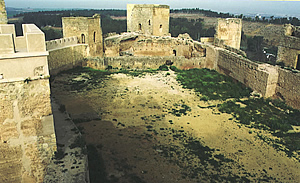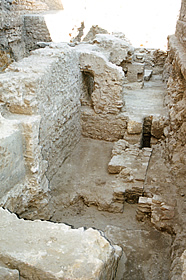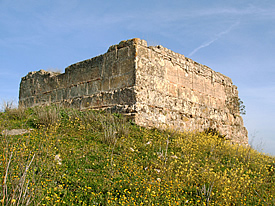


As it happened during the Roman period, along Al-Andalus period the territory organization is based on the agricultural exploitations (farmsteads). What do we know about these settlements? Colonists from Arabia and North Africa were settled down on them although we do not have any clue on how they related to Hispano-Visigothic natives. Al-Andalus agricultural settlement would enable the agricultural economy recovery, as well as technological and commercial exchanges.
During the middle centuries of Al-Andalus period, an important part of the present-day territory of Alcalá de Guadaíra was included in one of Seville's fiscal districts, al-Sahl (the Plain) district, making the name reference precisely to the agricultural extensions of the Guadaíra countryside and the Guadalquivir left bank.

The presence of farmsteads at the zone of Los Alcores and La Campiña is known to us not only through Archaeology as through written records, especially those later than Castilian Conquer from the 13th century. It is a complex landscape, with an intensive occupation of the territory, not only in agricultural spaces but also in the water courses. It is now when the rivermills appear at the zone, with various mill enclaves on the Guadaíra: La Aceña, Benarosa, Reha al-Qinana... all of them date back from a later period, possibly from the presence of Almohads in Al-Andalus (12IIth century ) on.
Once the settlement from Mesa de Gandul has disappeared ca. the 12th century, the main settlement that rises in Al-Andalus period is Qalat Yabir's fortification, placed on the Castle of Alcalá Hill. The circumstances of this military enclave are known: In 1161, within the Almohad offensive against Qarmuna (today Carmona) a military camp is installed in Qalat Yabir. It is possible that there existed a previous fortified structure, but it is at this moment when the core of the medieval fortification is built, even with some singular attachment such as a hammam ( baths) for the fortress garrison. After the Almohads' victory, Qalat Yabir would remain as a tributary fortification, where the surrounding farmsteads delivered taxes to the state representatives yearly.

Qalat Yabir's importance as fortress of Seville surroundings was strengthened because its role in water supply to the capital city from the 12th century on. In 1172, by order of Almohad Caliphate the old aqueduct is recovered, along with the water channels starting in Santa Lucia, which from that moment on would supply water to Seville, almost until the 19th century.
Along with Qalat Yabir, other settlements of certain importance (all of them fortifications) appear in this final moment of Al-Andalus: Marchenilla, near the road of Mawrur (today Morón) or La Membrilla Tower, by the River Guadaíra and Antequera's road.
